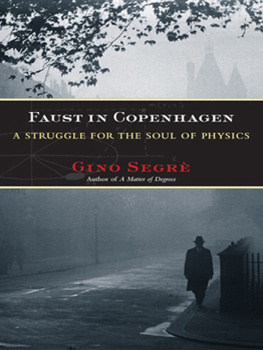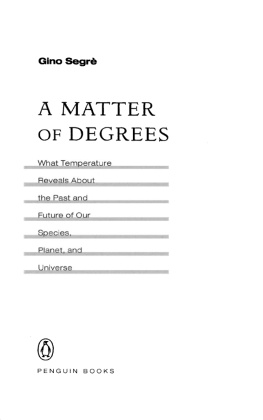GINO SEGR
Faust in Copenhagen
A Struggle for
the Soul of Physics
VIKING
VIKING
Published by the Penguin Group
Penguin Group (USA) Inc., 375 Hudson Street
New York, New York 10014, U.S.A.
Penguin Group (Canada), 90 Eglinton Avenue East, Suite 700, Toronto,
Ontario, Canada M4P 2Y3 (a division of Pearson Penguin Canada Inc.)
Penguin Books Ltd, 80 Strand, London WC2R 0RL, England
Penguin Ireland, 25 St. Stephens Green, Dublin 2, Ireland (a division of Penguin Books Ltd)
Penguin Books Australia Ltd, 250 Camberwell Road, Camberwell, Victoria 3124, Australia
(a division of Pearson Australia Group Pty Ltd)
Penguin Books India Pvt Ltd, 11 Community Centre, Panchsheel Park, New Delhi10 017, India
Penguin Group (NZ), 67 Apollo Drive, Rosedale, North Shore 0745, Auckland,
New Zealand (a division of Pearson New Zealand Ltd.)
Penguin Books (South Africa) (Pty) Ltd, 24 Sturdee Avenue, Rosebank,
Johannesburg 2196, South Africa
Penguin Books Ltd, Registered Offices: 80 Strand, London WC2R 0RL, England
First published in 2007 by Viking Penguin, a member of Penguin Group (USA) Inc.
Copyright Gino Segr, 2007
All rights reserved
Excerpts from Collected Works of Niels Bohr , series edited by E. Rudinger. By permission of Niels Bohr Archive, Copenhagen and Elsevier.
Excerpts from My World Line by George Gamow (Viking, 1970). Excerpts and drawings from Thirty Years That Shook Physics by George Gamow, illustrated by the author (Doubleday, 1966). By permission of Igor Garnow.
Excerpts from Scientific Correspondence with Bohr, Einstein, Heisenberg and Others by Wolfgang Pauli. By permission of Springer Verlag, Heidelberg.
ISBN: 978-1-1012-0238-8
Without limiting the rights under copyright reserved above, no part of this publication may be reproduced, stored in or introduced into a retrieval system, or transmitted, in any form or by any means (electronic, mechanical, photocopying, recording or otherwise), without the prior written permission of both the copyright owner and the above publisher of this book.
The scanning, uploading, and distribution of this book via the Internet or via any other means without the permission of the publisher is illegal and punishable by law. Please purchase only authorized electronic editions and do not participate in or encourage electronic piracy of copyrightable materials. Your support of the authors rights is appreciated.
In memory of George Gamow
Introduction
THIS IS A BOOK about seven physicists, six men and one woman, who attended a small annual gathering in Copenhagen in April 1932. To be honest, only six of them were actually there. The seventh, Wolfgang Pauli, had originally intended to go, as he had in earlier years and would do so again, but he decided that spring instead to take a vacation. He was there in spirit, as you will see.
Four of the sevenNiels Bohr, Paul Dirac, Werner Heisenberg, and Wolfgang Pauliwould be placed in most physicists selection of the centurys top ten physicists. Lise Meitner, the only woman in the group, ranks high on anyones list of the centurys most important experimentalists. Another of the seven, Max Delbrck, changed fields soon after the meeting, though he never stopped defining himself as a physicist. He went on to become one of the founding fathers of modern molecular biology and ranks as one of that disciplines top ten. All of them taught and mentored a generation of future scientists. The last of the seven, Paul Ehrenfest, was perhaps the greatest teacher of them all.
Physics was fortunate to have at one moment a remarkable number of individuals to help create and shape the great revolution in science called quantum mechanics. Indeed, one could say that the revolution occurred because of them. It developed very differently from relativity, the twentieth centurys other major departure from physics past. Relativity, in the special theory of 1905 and the general theory of 1916, was the work of a single individual, Albert Einstein. Both the special theory and the general theory were essentially complete in Einsteins initial formulations, requiring no revisions or subsequent interpretations. Quantum mechanics, on the other hand, emerged in 192526 only after a long buildup. Its details evolved over time, and its meaning continued to be debated for years. Unlike relativity, it was the work of many who struggled together, often arguing with one another as they hammered out the theorys conclusions. Its final version, the so-called Copenhagen interpretation, was contested even by some of the creators of the revolution. The questioning has not ceased.
Together Pauli, Heisenberg, Dirac, and the others created something remarkable, something that has changed all our lives in a practical sense more than any other twentieth-century scientific upheaval has. The inventions it led to, such as the transistor and the laser, are both implements that affect our daily activities and tools for future research.
This is, however, a book about the human side of science, describing not only what these physicists did but how they did it and what they were like. It focuses on these seven, though others will play a role too. Theres no single answer to the question of what they were like, since physicists are as different from one another as any other group. Among them we find the gregarious and the withdrawn, the philanderers and the faithful, the rooted and the wanderers. Some were abstemious and others drank too much. There were perhaps a disproportionate number of music lovers and mountain climbers among them, but that may be because they had been told these are things physicists do. Their working habits differed: some preferred the early morning and others the late night. Some always worked alone and others required discussions with their peers. But the founders of quantum theory had one thing in common: they were geniuses at the particular calling known as theoretical physics.
They had a second common trait, perhaps not independent of theoretical-physics genius. Three of the scientists, all born between 1900 and 1902, stand out for their precocity: by their midtwenties Pauli, Heisenberg, and Dirac were leaders in the founding of the field. Several older theoretical physicists, notably Bohr, Einstein, Max Born, and Erwin Schrdinger, also played extremely important roles in the revolution, but the youthfulness of its major participants remains a striking feature. All of them had revealed their powers and were famous in the field by the time they were thirty. More accurately, all but one had achieved great prominence by then, and that one, Schrdinger, may have simply been delayed in his intellectual flowering because his years between ages twenty-five and thirty were taken up by military service during World War I.
Among all these physicists, one stands out for his personal impact on the field and on the others, not simply for his thought or achievements. In his obituary for Bohr, Heisenberg wrote, Bohrs influence on the physics and the physicists of our century was stronger than that of anyone else, even than that of Albert Einstein. This seems, at first sight, to be the sort of generous testimonial one makes in obituaries, but Heisenberg was not given to exaggeration. I was surprised to read it, for my generation does not think of Bohr this way (I confess to being a theoretical physicist myself, though hardly in the range of geniuses). But the more I delved into the matter, the more I came to understand its truth. It is not based on relative intellectual contributions, for Einsteins were certainly far greater than Bohrs. It revolves around how Bohrs style affected the way physicists think and work, how they individually and collectively strive for answers, how they relate to their mentors, their peers, and their students. In the process of wielding this power, Bohr also became the most loved theoretical physicist of the twentieth century.











